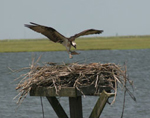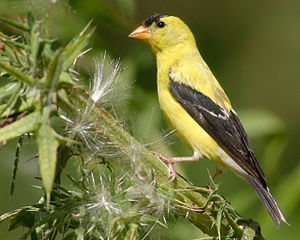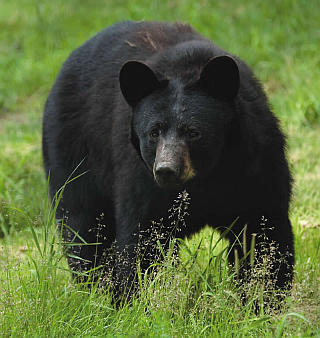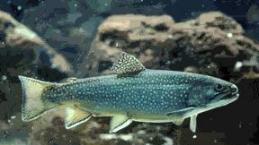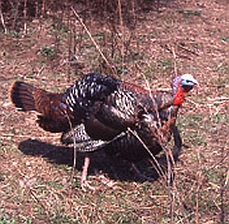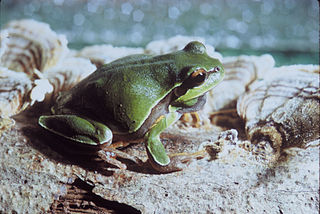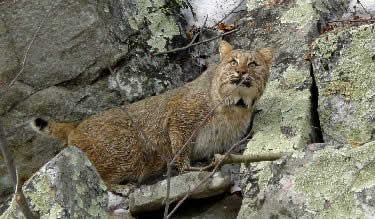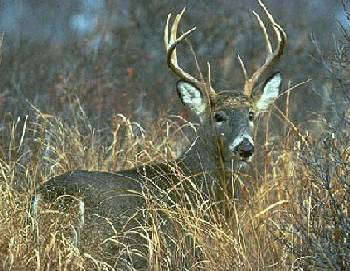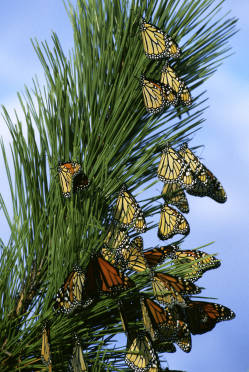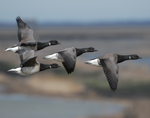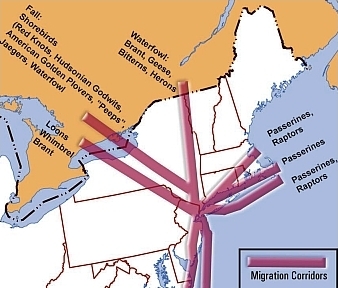-- Environment - Wildlife
Hover over or click image for caption
-See more images in our Wildlife Gallery
* Home
|
-- Overview
New Jersey currently hosts some 450 species of vertebrate wildlife along with 85 freshwater fish, according to the Division of Fish & Wildlife in the New Jersey Department of Environmental Protection. At various points during the year, the state's marine waters, bays and estuaries are habitat for 28 marine mammals and 336 marine finfish. New Jersey also is situated in the path of the Atlantic Flyway bounded to the east by the Atlantic Ocean and to the west by the Allegheny Mountains, the principal route for birds migrating annually to and from northern locations to the south and Latin America. For over forty years, New Jersey has been the site of the World Series of Birding organized by the New Jersey Audubon Society, at which teams from across the country compete to identify the most species over a single day, with the leading teams typically reporting well over 200 species. The state government maintains some 500,000 acres of state-owned public open space in state parks and other protected areas, including over 354,000 acres in 121 Wildlife Management Areas specifically managed to enhance wildlife populations and provide for wildlife-oriented recreation. The largest protected area is the Pinelands National Reserve in the southern part of the state, which comprises one-fifth of the state's land area and is subject to oversight of development under both federal and state legislation. The state also operates the Hackettstown Fish Hatchery to stock fish in rivers and streams and the Rockport Pheasant Farm to breed and raise pheasants for hunting in selected wildlife management areas. * State Parks and Recreation Areas, Division of Parks & Forestry, New Jersey Department of Environmental Protection * Wildlife Management Areas, Division of Fish & Wildlife, New Jersey Department of Environmental Protection * New Jersey Wildlife Viewing & Bird Watching Map, Conserve Wildlife Foundation of New Jersey * New Jersey Birding Locations and Sites, New Jersey Audubon Society * Charles O. Hayford State Fish Hatchery at Hackettstown, Division of Fish and Wildlife, New Jersey Department of Environmental Protection * Rockport Pheasant Farm, Division of Fish & Wildlife, New Jersey Department of Environmental Protection The federal government also pursues wildlife conservation at recreation and wildlife areas it maintains in New Jersey, including the Edwin B. Forsythe National Wildlife Refuge; Great Swamp National Wildlife Refuge; Supawna Meadows National Wildlife Refuge; Walkill River National Wildlife Refuge; Cape May National Wildlife Refuge; Gateway National Recreation Area; and Delaware Water Gap National Recreation Area. * Cape May National Wildlife Refuge, US Fish & Wildlife Service * Edwin B. Forsythe National Wildlife Refuge, US Fish & Wildlife Service * Great Swamp National Wildlife Refuge, US Fish & Wildlife Service * Supawna Meadows National Wildlife Refuge, US Fish & Wildlife Service * Wallkill River National Wildlife Refuge, US Fish & Wildlife Service * Gateway National Recreation Area, National Park Service * Delaware Water Gap National Recreation Area, National Park Service Hunting and fishing within the state is subject to regulation by the Division of Fish & Wildlife, which sets the calendar for allowed seasons and issues licenses along with other rules. New Jersey saltwater fishermen are required to register with the free New Jersey Saltwater Recreational Registry Program, but the state otherwise does not require a general saltwater fishing license, with the exception that harvesting of specific species such as shellfish are subject to limited number of saltwater licenses and permits. The federal government, through the National Marine Fisheries Service, also issues permits for coastal fishing for tuna and licenses for commercial fishing boats, as well as requiring reporting for catches of specific species including tuna and swordfish. Commercial fisheries in the state land over 120 varieties of marine finfish and shellfish valued in excess of $100 million annually, led by sea scallops, clams, mackerel, blue crabs, fluke, herring and lobster. There are six ports serving commercial fishing boats at Belford, Point Pleasant, Barnegat Light, Cape May, Port Norris and Atlantic City (shellfish only). The state also maintains registries of the largest fish caught in fresh and salt waters by sport fishermen. * Hunting & Fishing Licenses, Division of Fish & Wildlife, New Jersey Department of Environmental Protection * Saltwater permits, National Marine Fisheries Service * Mid-Atlantic Fishery Management Council * State Record Freshwater Fish, Division of Fish & Wildlife, New Jersey Department of Environmental Protection * State Record Saltwater Fish, Division of Fish & Wildlife, New Jersey Department of Environmental Protection * Cape May National Wildlife Refuge, US Fish & Wildlife Servicefws.gov/refuge/cape-may * Edwin B. Forsythe National Wildlife Refuge, US Fish & Wildlife Service * Great Swamp National Wildlife Refuge, US Fish & Wildlife Service * Supawna Meadows National Wildlife Refuge, US Fish & Wildlife Service * Wallkill River National Wildlife Refuge, US Fish & Wildlife Service * Gateway National Recreation Area, National Park Service * Delaware Water Gap National Recreation Area, National Park Service * Wildlife Management Areas, New Jersey Division of Fish & Wildlife, New Jersey Department of Environmental Protection * Nature Centers in New Jersey, Wikipedia -- Wildlife control
As the state with the densest population in the nation, New Jersey has debated how to control increasing interactions between wildlife and humans, particularly with growing numbers of deer, bears and coyotes. - Deer - In the late 1800s, deer had virtually disappeared from the state as a result of over-hunting, but by 2014 there were roughly 106,000 deer (down from about 200,000 in the 1990's as a result of state policies to reduce the population), according to New Jersey Department of Environmental Protection estimates. In the 2014-15 hunting season on the 750,000 acres of public land available for hunting, 52,704 were killed by firearms or bow and arrow. In addition to harvests by individual hunters, some municipalities have retained professional firms to reduce local deer populations. Approximately an additional 25,000 annually are killed by motor vehicles. The population trend is considered stable. - Bears - Efforts to control the bear population, estimated to have grown to 3,500 in 2022 from fewer than 100 in the 1970s, have been especially controversial, with protesters appearing at public hearings and picketing at hunting sites. There also have been increasing numbers of sitings in the central part of the state indicating a larger statewide population than the concentration in the northwestern part of the state. The ten-day hunt allowed in December 2015 resulted in the killing of 510 animals, somewhat below the state government's goal of reducing the population by a fifth. In 2014, a 22-year-old Rutgers student was killed by a bear while hiking on a trail in Sparta and shortly after the December 2015 hunt a Boy Scout leader was bitten by a bear in Rockaway Township as he was showing his scouts a cave which the bear was occupying. During his gubernatorial campaigns, Governor Murphy had opposed the bear hunts, but after increasing numbers of human encounters, he allowed restoration of the hunt in fall 2022, although only 114 bears were killed, half the 225 killed in 2018 and much below the anticipated number. - Coyotes - Coyote populations have increased since 1980 to currently number some 10,000 animals, although the state reports that they have not been restored as the result of any officially sanctioned import program. In New Jersey, adult coyotes range in weight from 20 to 50 pounds and exceptionally large ones may weigh up to 55 pounds. Sightings have been reported in all counties. * Hunting in New Jersey, Division of Fish & Wildlife, New Jersey Department of Environmental Protection * White-tailed Deer in New Jersey, Division of Fish & Wildlife, New Jersey Department of Environmental Protection * Coyotes in New Jersey, Division of Fish & Wildlife, New Jersey Department of Environmental Protection |
|
|
-- History Soon after they arrived, the first European settlers in New Jersey sought to exploit the colony's wildlife, not only for their own sustenance but for trade and commerce. The Dutch and Swedes set up trading posts to barter with the Lenni-Lenapes and other tribes for pelts from beaver, muskrats, rabbits and other fur-bearing animals. Later, the settlers on their own began to set traps or use firearms to hunt for the animals. By the 18th century, a flourishing industry had developed to fashion the pelts into apparel like hats and coats, later diversifying from the initial use of pelts from furs to the weaving of cotton and other textiles. The City of Orange, for example, became known as "hatter to the world," at its peak hosting some thirty hatmakers producing nearly five million hats. To the south, the first villages on Cape May were whaling ports, supporting the dangerous offshore pursuit of whales which continued until around 1700. Other towns grew along the coast and inland waterways; the importance of shellfishing along the Delaware Bay is suggested by the surviving place names of the once thriving oyster ports of Bivalve and Shellpile in Cumberland County. Pile of oyster shells outside processing plant in Bivalve in Cumberland County in photo taken in 1938. Image: Library of Congress
-- Government initiatives to preserve and restore wildlife
In the 1960s and 1970s, however, growing public awareness of the loss of habitat and the impact of ecological interference by pesticides and toxic waste brought a series of federal and state government actions intended to protect remaining animal populations. In 1966, a federal law authorized research to identify threatened species, and subsequent legislation, The Endangered Species Act of 1973, imposed strong controls on land-use development and other activities that would pose risks to the survival of imperiled species. Other legislation constrained the use of pesticides and other toxic chemicals, which had led to extinction or sharp population declines of species of birds, butterflies, fish and other animals. Regulation of hunting and fishing also was strengthened. In 1971, the New .Jersey Fish and Game Council, a unit first created in 1945 by the legislature and now within the Department of Environmental Protection, for the first time barred the hunting of black bear due to their limited numbers. With considerable controversy, marine fishing also was restricted as over-fishing of once-prevalent species like cod were threatened. In the wake of a disease that devastated oysters in the 1950s, strict limits on acreage allowed for harvesting was imposed by the state, and federal agencies sharply cut allowed catch limits of marine fish species like cod, striped bass and swordfish. Habitat protection also advanced. The state Green Acres program commenced in the 1960s to provide funds to both state and local governments to acquire lands for parks and wildlife preserves. In 1978, the Pinelands Protection Act, along with complementary federal legislation, led to strict controls over development of nearly a fifth of the state's area, with subsequent laws restricting building in freshwater wetlands and in the Highlands in the state's northwest region. * Fish & Game Council, New Jersey Department of Environmental Protection * Mid-Atlantic Fishery Management Council * Green Acres Program, New Jersey Department of Environmental Protection * New Jersey Pinelands Commission * New Jersey Highlands Council * Endangered and Threatened Wildlife, Division of Fish & Wildlife, New Jersey Department of Environmental Protection * Conserve Wildlife Foundation of New Jersey -- Research New Jersey's wildlife are the subject of various research programs conducted by the federal and state governments; academic institutions; and private associations and organizations. The Rutgers School of Environmental and Biological Sciences maintains several teaching and research programs, and includes the New Jersey Agricultural Experiment Station, the research and outreach arm of Rutgers with specialists conducting programs in areas including fisheries and insects. Rutgers was a pioneer in insect research, particularly in mosquito breeding and control. The Experiment Station's Haskin Shellfish Research Laboratory also conducted research on the parasite which devastated oyster production in the 1950s and developed oyster varieties resistant to the disease. The Station also sponsors the Barnegat Bay Shellfish Restoration Program, a partnership with the state Department of Environmental Protection's Bureau of Shellfisheries, to study and educate communities on shellfish ecology in the Bay. * School of Environmental and Biological Sciences, Rutgers University * New Jersey Agricultural Experiment Station, Rutgers University * Haskin Shellfish Research Laboratory, Rutgers University * Research, Conserve Wildlife Foundation of New Jersey |
